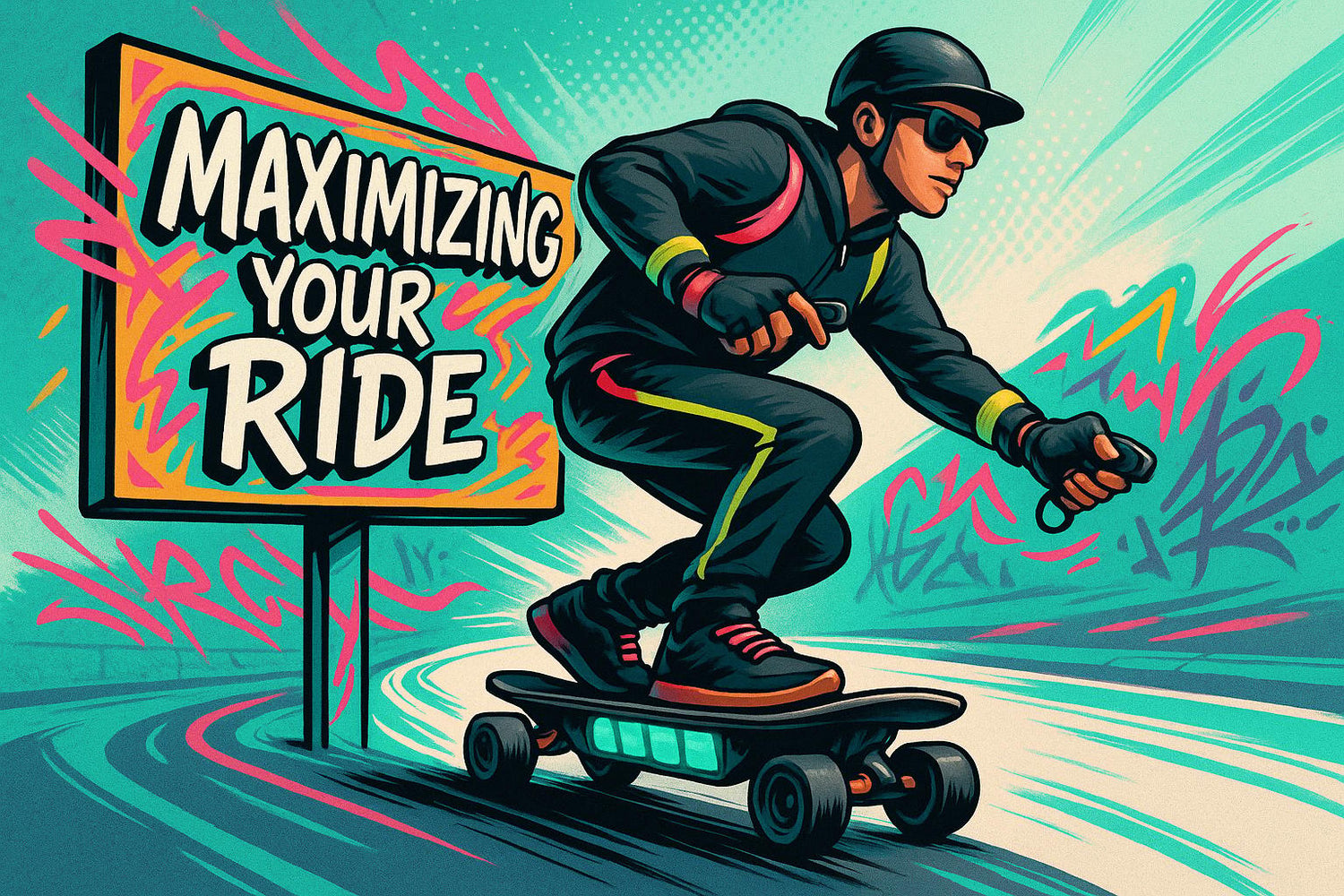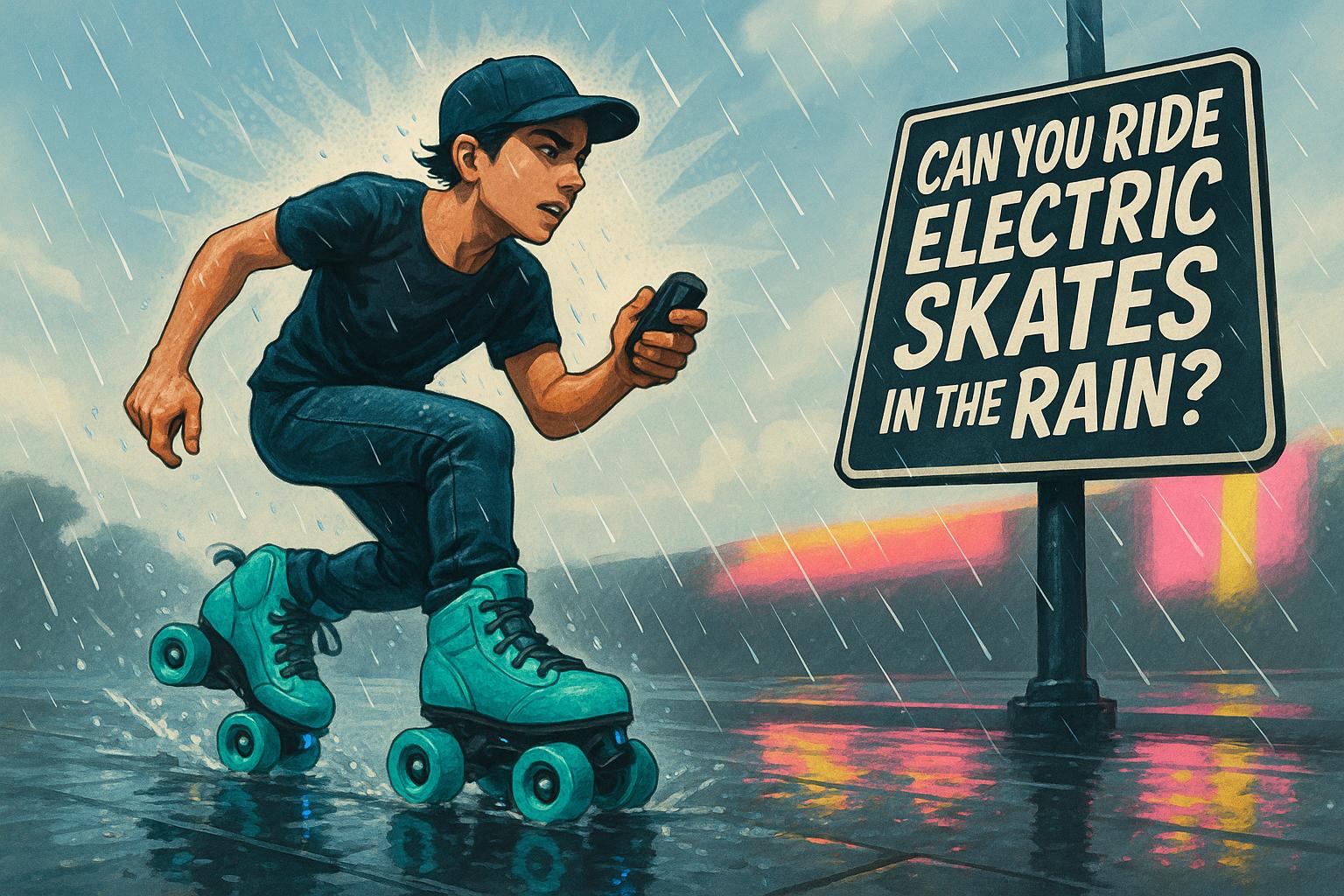Taking care of your electric skateboard battery is essential for better performance and saving money on replacements. Lithium-ion batteries, commonly used in e-skates, can last 1–3 years with proper care. Missteps like overcharging, deep discharges, or extreme temperatures can shorten their lifespan. Here’s a quick summary of what you need to know:
- Smart Charging: Avoid leaving the battery plugged in after it’s full. Charge in small increments (20–80%) and let the battery cool down after rides.
- Riding Habits: Accelerate gently, brake smoothly, and use regenerative braking to conserve energy.
- Storage Tips: Keep the battery at 50–60% charge for long-term storage and store it in a cool, dry place.
- Maintenance: Regularly clean the charging port and inspect for damage.
3 Ways You're Destroying Your Electric Skateboard Battery (& What To Do About It)
E-Skate Battery Basics: What You Need to Know
To get the most out of your electric skates, it's important to understand how your battery works. Think of the battery as the heart of your e-skates - it powers your rides and directly impacts performance. By grasping these basics, you'll set yourself up to dive deeper into battery types and performance details.
Battery Types Used in E-Skates
Most electric skates, including Wheelfeet models, rely on lithium-ion batteries. These batteries are widely used in personal electric transportation because they strike a great balance between power, weight, and durability.
Lithium-ion batteries are lightweight, which is especially important when you're carrying the weight on your feet. They also retain their charge well when not in use and can go through hundreds of charge cycles before showing noticeable wear.
Wheelfeet skates take advantage of lithium-ion technology to deliver efficient performance, support regenerative braking, and promote recycling opportunities. Regenerative braking captures energy as you slow down, feeding it back into the battery to extend your range.
These batteries typically operate at voltages between 24V and 36V, depending on the model. Higher voltage means more power for the motors, which translates to faster acceleration and better performance on hills.
Key Battery Terms Explained
Now that you know the type of battery, it's helpful to understand some key terms that affect performance and care. These concepts will guide you in managing your battery for the best results.
- Battery capacity: Measured in milliamp-hours (mAh) or amp-hours (Ah), this tells you how much energy the battery can store. A higher capacity means longer rides. For instance, a 4,000 mAh battery will last about twice as long as a 2,000 mAh one.
- Charge cycles: This refers to how many times you can fully charge and discharge a battery before it starts losing capacity. Most lithium-ion batteries for e-skates are rated for 300-500 charge cycles. After that, they may only hold 70-80% of their original capacity.
- Voltage: Voltage determines the amount of power delivered to your motors. A higher voltage typically provides more torque, better hill-climbing ability, and faster speeds. Wheelfeet skates can hit speeds of up to 15 mph, thanks in part to their optimized voltage setup.
- C-rating: This measures how quickly a battery can safely discharge its stored energy. A higher C-rating means the battery can handle quick bursts of power, which is useful for acceleration and climbing steep hills.
- Depth of discharge (DoD): DoD indicates how much of the battery's capacity is used before recharging. For example, using 50% of the battery's charge represents a 50% DoD. Keeping this number lower can help extend the battery's overall lifespan.
- State of charge (SoC): This is the percentage of charge remaining in your battery. Most e-skates have indicators to show your current SoC, so you can plan your rides and charging schedule accordingly.
Best Charging Practices for Longer Battery Life
Taking good care of your battery starts with understanding how to charge it properly. The way you charge your battery can have a big impact on its performance and lifespan. By developing smart charging habits, you can help maintain your battery's health and ensure it performs reliably over time. It’s all about knowing what helps your battery thrive and what might wear it down.
Charging Dos and Don'ts
Here are some key tips to avoid unnecessary stress on your battery:
- Don’t leave your e-skate plugged in after it’s fully charged. Keeping the battery at 100% for too long can strain it.
- Avoid deep discharges. If you’re storing your e-skate, aim to keep the charge level around 50–60%.
- Let the battery cool down after a ride. Wait 15–30 minutes before charging if the battery feels warm. Charging a hot battery can reduce efficiency and cause extra wear.
- Keep the charging port clean and dry. Dirt, moisture, or debris could interfere with the connection and might even cause overheating or short circuits.
By following these simple steps, you set yourself up for safer and more efficient charging.
Setting Up Safe Charging Areas
Creating a safe environment for charging protects not only your battery but also your home. Here’s how to do it:
- Charge indoors in a well-ventilated space. The ideal temperature range is between 50–86°F (10–30°C).
"Charge on a Non-Flammable Surface – Never charge on a bed, couch, or carpet. Use a hard, flat surface with ventilation." - Skateboard Australia
- Keep the charging area away from heat sources. Avoid direct sunlight, radiators, space heaters, or anything that could raise the temperature.
- Avoid charging near exits.
"Never charge your device near an exit, as it could block your escape in the event of a fire." - UL Standards & Engagement
- Remove flammable items. Clear away paper, fabric, or cleaning supplies from the charging area to reduce fire risks.
Charging Habits Comparison
Different charging methods can affect your battery’s health in the long run. Here’s a breakdown of common practices:
| Charging Habit | Impact | Recommendation | Long-term Effect |
|---|---|---|---|
| Overnight charging | Keeps the battery at full charge for too long, stressing the cells | Avoid leaving the charger connected overnight | May reduce battery capacity over time |
| Partial charging (20–80%) | Reduces stress by staying within a moderate charge range | Recharge as needed without waiting for full discharge | Helps extend battery lifespan |
| Full discharge then charge | Deep discharges can strain the battery | Avoid letting the battery fully deplete | Can shorten overall battery lifespan |
| Frequent topping off | Keeps the battery in an optimal state | Charge in small, frequent increments when possible | Maintains steady performance |
| Temperature-controlled charging | Ensures charging happens under safe thermal conditions | Let the battery cool down before charging if warm | Promotes consistent performance |
Smart Usage Patterns to Extend Battery Performance
Tweaking your riding habits can go a long way in squeezing more life out of each charge while keeping your battery in good shape. Pair these strategies with the charging and storage tips mentioned earlier to get the most out of your e-skate battery.
How Riding Style Affects Battery Life
The way you ride has a direct impact on your battery's performance. Quick, aggressive acceleration burns through battery power much faster than smooth, gradual starts. Likewise, cruising at high speeds demands more energy to sustain momentum, which can shrink your range. Abrupt braking not only wastes energy but also forces your motor to work harder when you speed up again. Factors like rider weight and steep inclines also contribute to increased energy consumption. To help your battery last longer, aim for smooth and steady movements - accelerate gently and plan your stops ahead of time. These small adjustments can make a big difference in preserving energy.
Using Regenerative Braking Effectively
Regenerative braking is a clever way to recover energy while you slow down. Many e-skates let you adjust the braking intensity using a remote, allowing you to fine-tune how much energy is captured during deceleration. This feature is especially useful in urban settings where frequent stops are common. By practicing smooth, controlled braking, you not only maximize energy recovery but also ease the strain on your battery over time. Over time, this habit can contribute to a longer range and a healthier battery.
sbb-itb-bf837b9
Proper Maintenance for Long-Term Battery Health
Alongside smart charging habits and mindful riding techniques, regular maintenance plays a big role in keeping your battery in good shape over time. Make it a habit to check your e-skate's battery and electrical components before and after every ride. Look for any signs of damage or unusual sounds that might indicate an issue.
Don't stop there - inspect other parts like the deck, wheels, bearings, and trucks to ensure they're in good condition and securely fastened. Catching problems early can save you from bigger headaches later, like serious damage or a drop in performance.
Common Battery Care Mistakes to Avoid
Simple missteps can take a serious toll on your e-skate battery's lifespan. Beyond adopting good charging and usage habits, steering clear of these common errors is essential to keeping your battery in top shape.
Top Mistakes That Damage Batteries
Using an incompatible charger is a frequent mistake that can harm your battery. While it might be tempting to use any charger that fits, an incorrect voltage or amperage can lead to overheating and permanent damage. Always stick with the manufacturer-approved charger that came with your e-skates.
Leaving your skates plugged in after they’re fully charged can stress the battery cells, reducing their longevity. Unplug once charging is complete.
Allowing your battery to drain completely during rides can weaken lithium-ion cells and potentially cause structural harm. Aim to recharge before the battery dips too low.
Storing your skates in extreme temperatures is another common error. High heat can speed up chemical degradation, while freezing conditions can damage the cells. A stable, moderate environment is best for storage.
Neglecting cleaning and maintenance can also lead to problems. Dirt, moisture, and debris around charging ports and battery connections can cause corrosion and reduce efficiency.
Expert Tips for Better Battery Health
Developing a routine for battery care can go a long way in preventing these issues.
- Keep an eye on battery levels and range. This helps you spot early signs of performance decline before they escalate.
- Charge in a climate-controlled space. Avoid garages or attics where temperatures can swing drastically.
- Clean the charging port regularly. Use a dry cotton swab or compressed air to remove dirt and debris, and check for corrosion on metal contacts.
- Opt for partial charges during daily use. Save full charges for longer rides to reduce long-term stress on the battery, as discussed earlier in Best Charging Practices.
With regular cleaning, careful charging, and mindful usage, you can maintain your battery’s performance for the long haul. Avoiding these common mistakes ensures your e-skate stays powered and ready for every ride.
Conclusion: Key Takeaways for Better E-Skate Battery Life
Taking care of your e-skate battery is the key to getting the most out of every ride and ensuring your investment lasts. With proper maintenance, a lithium-ion battery can provide between 500 and 1,000 charge cycles, which translates to about 1–3 years of dependable use.
To preserve these cycles, follow smart charging habits. Always use the charger designed for your battery to avoid overheating and damage. Aim to keep the charge level between 20% and 80% during regular use, and steer clear of letting the battery drain completely. Deep discharges can trigger harmful chemical reactions that shorten its lifespan.
Your riding habits and storage conditions also play a big role in battery health. Let the battery cool down after intense rides, and store your e-skate in a place with moderate temperatures. Whether you're commuting to work or cruising on the weekends, these small adjustments can go a long way in maintaining consistent performance and avoiding the stress of sudden power loss.
FAQs
How can I tell if my e-skate battery is losing capacity, and what can I do to make it last longer?
You might notice your e-skateboard battery starting to wear out if the range suddenly drops, it gets unusually hot while charging or riding, or the charging process becomes noticeably faster or slower. Other warning signs include swelling or a burning smell. If any of these happen, it’s a clear signal that the battery may be nearing the end of its life.
To help your battery last longer, try to keep its charge level between 20% and 90% during regular use. If you’re not planning to use your e-skateboard for a while, store the battery at about 50-60% charge. Also, avoid exposing it to extreme temperatures - whether too hot or too cold - and stick to using the charger recommended by the manufacturer. These habits can go a long way in preserving your battery’s health.
What happens if I use a charger that isn’t approved for my e-skate battery?
Using a charger that hasn’t been designed for your e-skate battery can lead to serious problems and even damage your battery. Chargers that don’t meet the required voltage and current levels can cause overcharging, overheating, or even permanent harm to the battery.
When a battery is overcharged, it experiences unnecessary strain, which can shorten its lifespan and reduce its overall performance. On top of that, using an improper charger can make the battery overheat - this not only wears out the battery but also poses safety risks, including the possibility of fires. To keep your battery in good shape and avoid these dangers, stick to the charger provided by the manufacturer or one that exactly matches your e-skate battery’s specifications.
What is regenerative braking in e-skates, and how can I use it to improve my battery life?
Regenerative braking in e-skates is a smart way to make your rides more efficient. It works by capturing the energy produced during braking or when you're cruising downhill and channeling it back into the battery. This process helps to stretch your battery life, giving you more time on the road.
For the best results, aim to brake smoothly instead of coming to sudden stops. Gradual braking gives the system more time to recover energy. Similarly, take advantage of regenerative braking while going downhill to get the most out of this feature. Adopting these practices can not only boost your battery's range but also make your rides smoother and more enjoyable.




Leave a comment
All comments are moderated before being published.
This site is protected by hCaptcha and the hCaptcha Privacy Policy and Terms of Service apply.